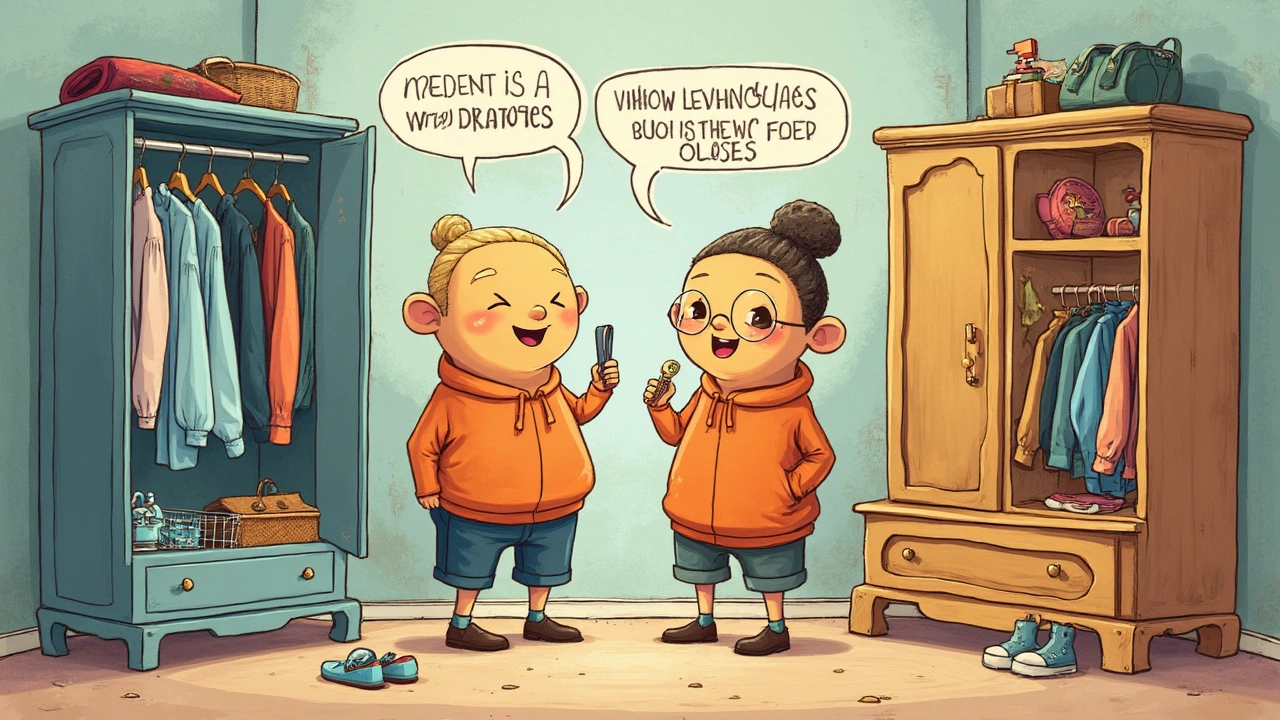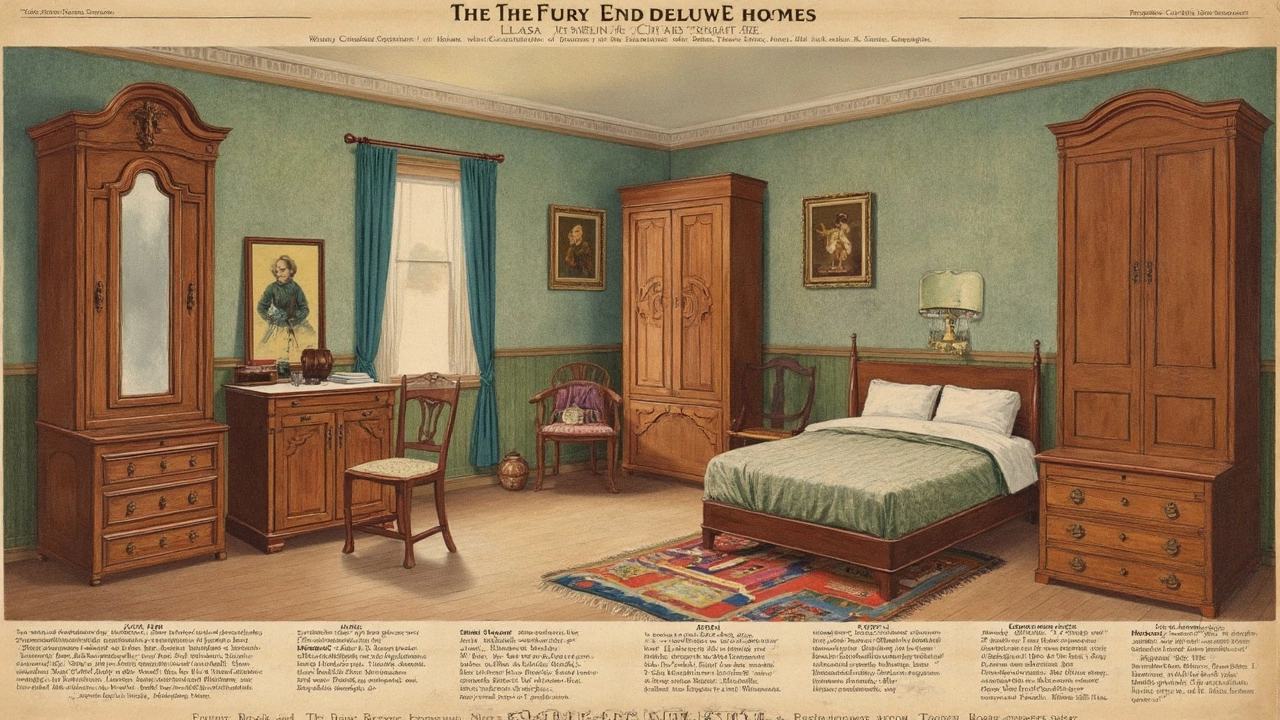You're flipping through a furniture catalog, and something catches you off guard. You've always heard the term 'wardrobe' tossed around in movies and books, but here in America, the conversation seems to center around 'closets'. So, what gives? Turns out, in the U.S., the term 'closet' is the go-to word for what many folks across the pond might call a wardrobe.
Now, let's clear one thing up. A closet and a wardrobe aren't exactly the same, even if they're often used interchangeably. A wardrobe is a standalone piece of furniture, while a closet is typically a designated storage space within your walls. Knowing this difference can be super handy, especially if you're planning on revamping your home or just trying to figure out what to do with that extra room.
- The Closet Mystery
- Wardrobes vs. Closets: What's the Difference?
- A Brief History Lesson
- Making the Most of Your Space
- Design Trends and Ideas
- Shopping Tips and Tricks
The Closet Mystery
Alright, let's talk about the great 'closet' vocabulary muddle in America. Why do Americans call near-every storage space a closet? It's all tied to how homes are designed here. Most American homes get built with these predefined spaces already in place, while in many other parts of the world, you’d buy a wardrobe separately. But there's more to it than just architecture.
Back in the day, the word 'closet' meant a private room used for study or prayer. Fast forward, and it shifted to mean a space used for storage within walls. According to Dr. Emily Smith, a respected historian specializing in American culture, "The American closet shows an evolution of space usage, fitting our changing lifestyles and the tendency to have everything built-in."
"The American closet shows an evolution of space usage, fitting our changing lifestyles and the tendency to have everything built-in." - Dr. Emily Smith
It's worth noting the psychological shift too. Americans prize ample storage, leading to the 'walk-in closet,' a room-sized version of what others might just call a cupboard. It's like the ultimate symbol of space optimization!
So, next time you hear someone mention a wardrobe, just remember it's mostly about how and where stuff is stored. For those who appreciate numbers, a fun fact: the average American closet is designed to store about 7 times more clothes than its European counterparts. It shows just how much value is placed on accessible storage.
Understanding this terminology can be super helpful, especially if you’re looking to shake things up at home. It clears up confusion at furniture stores, and you can use it to your advantage when planning the layout of your house or apartment. Remember, your closet doesn’t just have to be for clothes. With the right shelves, it’s a multi-purpose storage wonder!
Wardrobes vs. Closets: What's the Difference?
When it comes to storing clothes and other essentials, the terms wardrobes and closets get thrown around a lot. However, while they may seem similar, they have distinct differences. Understanding these can save you a lot of headaches when organizing your home.
First up, the wardrobe. A wardrobe is basically a standalone piece of furniture that you can place anywhere in a room. It comes with doors, and often, additional drawers at the bottom for extra storage. It's like a large cabinet—you won't need any construction or installation, just a bit of floor space.
The good old closet, on the other hand, is more like a built-in feature. Typically, it will be an architectural element in a home, with a door or an open entryway that leads into storage space within the walls. This inner space is where you get to customize shelving, rails, and drawers to fit your stuff. Talk about a little remodeling magic!
So what's the benefit of one over the other? Here's a quick breakdown:
- Wardrobe: Great for renters or spaces where building into walls isn’t an option. Plus, they add charm with their design variety.
- Closet: Maximizes room space since everything's neatly tucked away inside the walls. They're often seen as modern solutions.
Most people in America opt for closets due to their space efficiency and modern look—especially in new homes. But if you're fixed on customizing your style, a wardrobe might just be your perfect pick.
A Brief History Lesson
So, how did we get from wardrobes to closets in the American household? Let's rewind a bit. The word 'wardrobe' dates back to medieval Europe, where it described a room used for storing clothes. This room would often have wooden cupboards or armoires—basically large, ornately designed boxes with doors. Fancy, right?
Fast forward to when the colonists landed in America; all that European flair wasn't exactly practical. America had its own style, and soon enough, the practical and built-in closet began to take over. Why bother with heavy wooden furniture when you can have the convenience of a space carved into your home?
As homes evolved, so did our storage needs. By the mid-20th century, closets were the norm in new American homes. They offered flexibility and a built-in place for your stuff without eating up floor space. Meanwhile, back in Europe, traditional wardrobes remained popular, especially in older buildings where closets weren't initially built.
For those wondering about the big shift, it's worth noting that having a closet became a mark of modernity in the U.S. It was all about maximizing space and keeping things tidy. Balancing practicality and design has long been a hallmark of American home innovation.
Even today, the charm of standalone wardrobes is making a comeback, thanks to their elegance and the desire for customizable furniture. Whether you call it a wardrobe or a closet, both aim to keep your home stylishly organized.

Making the Most of Your Space
So, you've got a wardrobe or a closet, and you're wondering how to make it work best for you. First things first, let's face it: storage always seems to run out faster than we'd like. But, fear not! There are some strategies you can use to maximize your space and keep things looking tidy.
Start by decluttering. It's the golden rule. Go through your clothes and accessories and get rid of anything you haven't worn in a year. You’ll be surprised by how much room you can create. Once you've cleared out the clutter, sort your items by type or season.
- Shelving: Look into adjustable shelves. They give you the flexibility to accommodate items of different sizes, from tall boots to folded sweaters.
- Hang it up: A double-hanging rod can instantly double your hanging space. Just make sure you're using slim, non-slip hangers to maximize the available room.
- Bins and Baskets: Perfect for storing seasonal items or bulky clothing. Label them so you can easily grab what you need without making a mess.
- Use the Doors: Don’t ignore the back of your closet door. Install hooks or over-the-door organizers for things like scarves, belts, or jewelry.
The key is to keep things organized and accessible, so you're not spending 20 minutes every morning trying to find your favorite sweater. Plus, a neatly organized space just feels good, like a little win in your daily routine!
Need a fun fact to convince you? Studies have shown that an organized wardrobe or closet can actually reduce stress and improve mood. It's like getting a free serotonin boost every time you open those doors.
Design Trends and Ideas
When it comes to keeping up with wardrobes and their cousins, closets, one thing's for sure: home design trends are always evolving. In America, folks are getting creative with how they use these spaces in their homes. It's not just about hanging clothes anymore—it's about making a statement.
For a fresh take on wardrobes, open-concept closets are taking the spotlight. People are tearing down walls (literally) and opting for open shelving that blends into the bedroom. This not only maximizes space but also keeps everything visible and within reach, making mornings a bit less of a hassle when you’re trying to find that one shirt you love.
Color is another game-changer. Traditional wood finishes still have their charm, but more and more people are painting their wardrobes in bold, vibrant hues or even stark, modern whites. It adds a pop of personality and gives a room that custom, curated feel without a huge investment.
On the tech side, smart wardrobes are making their debut. Imagine a wardrobe that can suggest outfits based on the weather or run an inventory of what you own. While it sounds futuristic, integrating tech isn’t all that complicated and is becoming quite popular in new builds or renovations.
- Use LED lighting within your wardrobes or closets. It not only makes things easy to find but also adds an upscale vibe.
- Consider modular closet systems. They’re customizable and you can adapt them as your needs and clothing collections change.
- Play with textures. Mixing materials like glass, metal, and natural woods can make a wardrobe visually interesting.
For those who love a DIY challenge, refurbishing old wardrobes to give them a whole new character is trending. It's a great project for a long weekend and contributes to sustainable living.
As far as numbers go, did you know that Americans spend on average $40 billion a year on home décor and organization? That's a lot of cash going towards creating spaces that aren't just functional but also reflect personal style. Whether you're building new or revamping the old, keeping ahead of these design trends can help create a space that's both practical and stylish.
Shopping Tips and Tricks
When diving into the world of wardrobes and closets, a few smart shopping tricks can save you time and cash. First off, don't be shy about hitting up both big-name furniture stores and local thrift shops. Sometimes, a vintage piece can add just the right charm to your home for a fraction of the price.
Size matters! Always measure your space before making any purchase. It's super frustrating to fall in love with a wardrobe only to discover it doesn't fit through your front door. And while you're at it, think about what's going into that wardrobe. More hanging space? Or do you need drawers for all those sweaters? Make a list of your priorities.
"Don't skimp on quality. A well-made wardrobe can last decades," advises interior design guru, Joanna Gaines.
When it comes to materials, solid wood pieces are sturdy but can be pricey. If you're on a budget, consider high-quality laminate, which offers durability without the hefty price tag. Don't forget to check out online marketplaces for deals. They can be a goldmine for finding unique pieces.
Here's a quick checklist to keep you on track:
- Determine the type and size of wardrobe or closet you need.
- Set a budget and stick to it.
- Explore both new and used options.
- Check the materials and construction for quality.
- Read reviews if you're purchasing online.
A helpful stat for the skeptics: 78% of online buyers read reviews, and those reviews can make or break your decision. So always do your homework!
By following these straightforward tips, you'll likely find the perfect wardrobe without breaking a sweat—or your bank account.


Write a comment